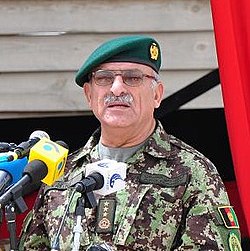6. Reaction Captain
- has some command responsibility for the reactions of 8 neighbouring Mobile Reaction Depots
- is the reaction director for the central 4 depots of these 8 neighbouring depots
- is the deputy reaction director for the peripheral 4 depots of these 8 neighbouring depots.
Reaction Captains direct Mobile Reaction Depots
The diagram illustrates how the command responsibility of neighbouring Reaction Captains is organised.
Mobile Reaction Depots 1 & 2
- the reaction director is Reaction Captain C
- the deputy reaction director is Reaction Captain A
Mobile Reaction Depots 3 & 4
- the reaction director is Reaction Captain A
- the deputy reaction director is Reaction Captain C
Mobile Reaction Depots 5 & 6
- the reaction director is Reaction Captain A
- the deputy reaction director is Reaction Captain D
Mobile Reaction Depots 7 & 8
- the reaction director is Reaction Captain D
- the deputy reaction director is Reaction Captain A
Mobile Reaction Depots 9 & 10
- the reaction director is Reaction Captain D
- the deputy reaction director is Reaction Captain B
Mobile Reaction Depots 11 & 12
- the reaction director is Reaction Captain B
- the deputy reaction director is Reaction Captain D
Mobile Reaction Depots 13 & 14
- the reaction director is Reaction Captain B
- the deputy reaction director is Reaction Captain E
Mobile Reaction Depots 15 & 16
- the reaction director is Reaction Captain E
- the deputy reaction director is Reaction Captain B
This overlapping organisation ensures that emergencies which are declared at any Mobile Reaction Depot can be supported if needs be by Reaction Captains with responsibility for the depot under attack ordering neighbouring depots on either side to react to the emergency.
A vehicle is assigned to each Reaction Captain who routinely drives to visit the 8 Mobile Reaction Depots for which he has command responsibility for daily meetings with the Depot Commanders and with the other 2 Reaction Captains he shares depot command responsibility with.
The Reaction Captains can arrange to receive a salute at attention from each off-duty shift twice a week with an opportunity for the Reaction Captains to boost morale by reminding the Gunners that every Reaction Captain has 8 Mobile Reaction Depots and 320 soldiers under his command and that the 2 Reaction Captains with command responsibility for a particular depot have between them 480 soldiers under their command.
So in emergencies the Secure Supply Route Protection Force is well organised to defeat any attack the enemy dares to try against any part of the supply route. They shall not pass! (No passeran!)
The Reaction Captain has a captain's office and quarters adjacent to one of the 4 Mobile Reaction Depots for which he is the reaction director and the Depot Commander of that particular Mobile Reaction Depot also serves as the Reaction Captain's secretary to take telephone calls to the Reaction Captain's Office if he is out of his office and quarters at the time.
Being so mobile in his daily routine, the Reaction Captain must be contactable via radio or mobile (cell) telephone when he is out of his office.
In the event of a major attack, the Reaction Captain will set up a tactical command headquarters at his office to direct the battle and call for further reinforcements from neighbouring Reaction Captain's offices if required.
Staff numbers
Reaction captain's office
1 office every 4 depots
161 men
- four depots of forty men (4 x 40 = 160)
- plus the Reaction Captain (160 + 1 = 161)
Mobile reaction depot
1 depot every 2 kilometres (1.25 miles)
40 men
- three eight-hour shifts of thirteen men, (3 x 13 = 39)
- plus the Depot Commander (39 + 1 = 40)
40 men per 2 kilometres = 20 men per kilometre = 32 men per mile
Depot shift
3 shifts per depot
13 men
- four three-man gun teams, ( 4 x 3 = 12)
- plus the Shift Officer (12 + 1 = 13)
Reserves
Approximate numbers of infantry required including reserves.
For a 25% reserve of 5 reserves per kilometre, 8 reserves per mile
Force including reserves is 25 infantry per kilometre, 40 infantry per mile
For a 50% reserve of 10 reserves per kilometre, 16 reserves per mile
Force including reserves is 30 infantry per kilometre, 48 infantry per mile
Support staff
Infantry deployed in the field or on guard somewhere can require numbers of support staff (such as delivery and rubbish collection, engineers of all kinds, trainers, medical, administration, military policing etc.) which I am told can be multiples of the numbers of deployed infantry they support, depending on the support facilities offered, the quality and efficiency of the support organisation.
I believe the support staff requirements for a static guard force are somewhat different to mobile infantry advancing (or retreating) in a conventional war because the guard force's requirements for fuel and ammunition deliveries are less but a guard force may expect more in terms of base facilities - running water, electricity and so on.
I am not recommending figures for support staff because such numbers are more dependent on the infrastructure of the army and nation concerned and are independent of the details of how the infantry are deployed which is my concern here only. Numbers of support staff are to be filled in by NATO-ISAF and the Afghan government and army themselves later.










 )
)

Bookmarks